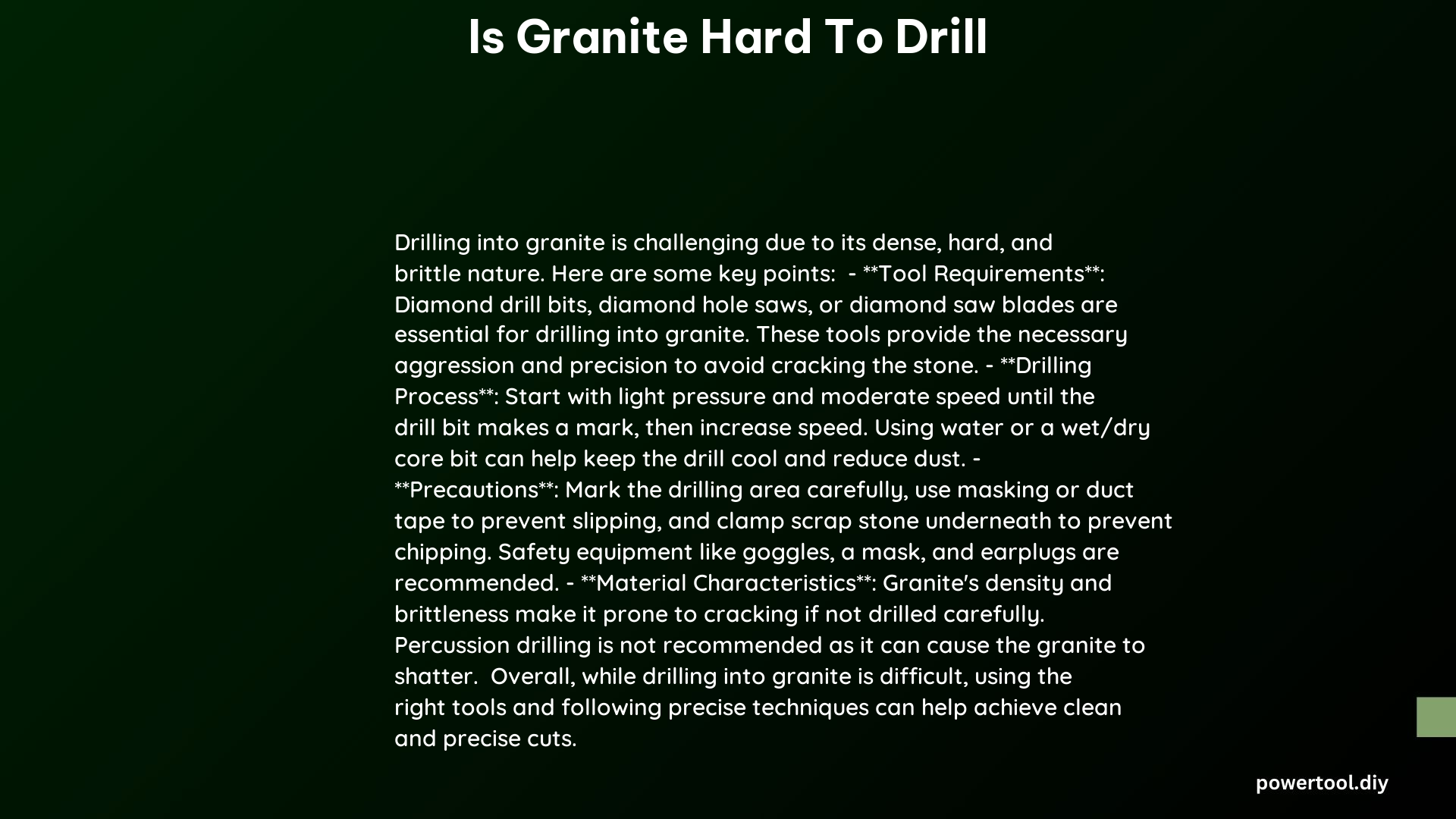Granite is indeed hard to drill due to its high rating on the Mohs hardness scale and significant compressive strength. This igneous rock poses challenges for drilling, requiring specialized tools and techniques. Despite its hardness, with the right equipment and methods, drilling granite is achievable. This article explores the factors that make granite difficult to drill, the best tools for the job, and effective techniques to overcome these challenges.
What Makes Granite Challenging to Drill?
How Hard is Granite on the Mohs Scale?
Granite ranks between 6 and 7 on the Mohs hardness scale, indicating its substantial resistance to scratching and wear. This high hardness rating is a primary factor in the difficulty of drilling through granite.
What is the Typical Compressive Strength of Granite?
The compressive strength of granite typically ranges from 100 to 250 MPa. This high strength, combined with its hardness, contributes significantly to the challenges faced when drilling through granite.
What Are the Best Drill Bits for Granite?

Which Materials Are Most Effective for Granite Drill Bits?
For drilling granite, the most effective drill bits are:
- Diamond-tipped drill bits
- Exceptional hardness and durability
- Most recommended for granite drilling
-
Can effectively cut through hard granite with minimal wear
-
Carbide-tipped drill bits
- Less effective than diamond-tipped but still usable
- May wear out faster when drilling granite
What Drill Bit Diameters Are Commonly Used for Granite?
Common diameters for granite drill bits include:
- 1/4 inch (6 mm)
- 1/2 inch (12 mm)
- Larger diameters for specific applications (require more powerful drills)
Which Brands Offer Reliable Granite Drill Bits?
Recommended brands for granite drill bits:
- Bosch
- DEWALT
- Makita
- Hilti
What is the Optimal Drilling Speed for Granite?
What RPM Ranges Are Suitable for Drilling Granite?
The optimal drilling speed for granite typically falls within 600 to 1200 RPM:
- Lower RPMs (600-800 RPM): Used for larger diameter bits
- Higher RPMs (1000-1200 RPM): Suitable for smaller diameter bits
How Does Speed Affect Drill Bit Wear?
Higher drilling speeds can:
– Increase drilling efficiency
– Increase risk of bit wear and overheating
Balancing speed with bit integrity is crucial for successful granite drilling.
What Techniques Are Effective for Drilling Hard Stone Like Granite?
How Can Cooling Methods Improve Granite Drilling?
- Water Cooling
- Significantly reduces heat buildup
- Extends drill bit life
-
Highly recommended for granite drilling
-
Dry Drilling
- Possible but not recommended
- Can lead to rapid bit wear and overheating
What is the Recommended Feed Rate for Drilling Granite?
A controlled feed rate is essential:
– Recommended rate: 1-2 inches per minute
– Helps avoid applying excessive pressure
– Prevents bit binding or breaking
How Do Pilot Holes Assist in Granite Drilling?
Using pilot holes:
– Guides larger drill bits
– Reduces risk of bit slipping or binding
– Particularly useful for large holes
What Are the Costs Associated with Granite Drilling Tools?
| Tool/Material | Price Range |
|---|---|
| Diamond-tipped drill bits | $20 – $100+ |
| Carbide-tipped drill bits | $10 – $50 |
| Drill machines suitable for granite | $100 – $500+ |
What Are the Noise and Vibration Levels When Drilling Granite?
Drilling granite generates significant noise and vibration due to its hardness. Safety precautions include:
- Using ear protection
- Wearing protective gloves
- Employing vibration-dampening techniques when possible
By understanding these factors and employing the right tools and techniques, drilling granite becomes a manageable task despite its inherent hardness and strength.
References:
1. Understanding the Hardness of Granite Natural Stone
2. Granite Mohs Scale [Understanding The Hardness Of Granite]
3. Rock Stone Classification and Stone Hardness
